Visit the Souks of Marrakesh
The Souks of Marrakesh or the markets filled with arts, crafts, clothing, jewelry and many other hand made items made in the area and sold in the many souks of Marrakesh to explore, bargain and do some major shopping. You’ll know that most shop keepers are used to tourists from around the world and speak in many different languages and are used to bargaining which is a normal activity at all of these souks.
Most of these souks offer more traditional style clothing, accessories, fixtures and home products that you’ll always remember as your keepsake visiting Marrakesh.
Most of the souks are easily reached from the main square called Jemaa El Fna and are a maze of stores, markets and even small stands selling everything from cheap souvenirs to really high end light fixtures, accessories and other gift items to take home as souvenirs.
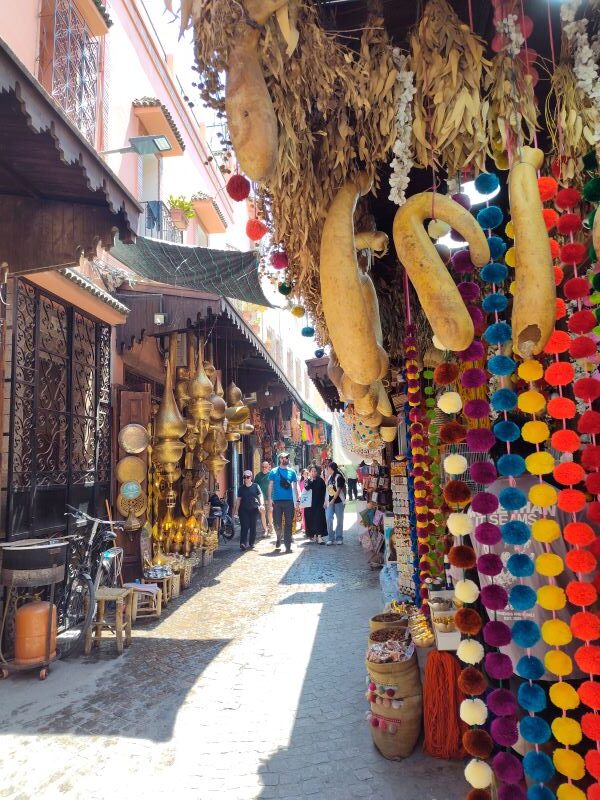
Explore the Souks of Marrakesh – specialty stores, accessory shops, home goods and all sorts of traditional to modern inspired products
It’s easy enough to explore the many souks off the main square of Marrakesh called Jemma el Fna and easily get lost along the way, but you can easily use any apps and location maps to target specific souks from the spice markets, design centers to mostly home focused products to shop around for.
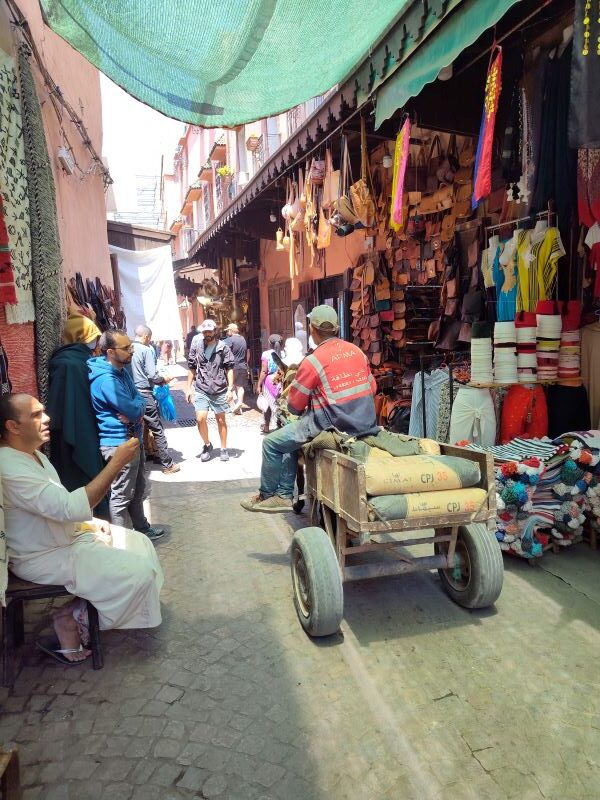
What are the souks of Marrakesh
1. Introduction to the Souks
- The souks of Marrakesh are a maze of narrow alleys and market stalls located within the historic Medina.
- They serve as the city’s commercial heart where artisans, traders, and shoppers meet.
- Each souk is traditionally organized by trade or craft, a practice dating back centuries.
2. Main Souks to Explore
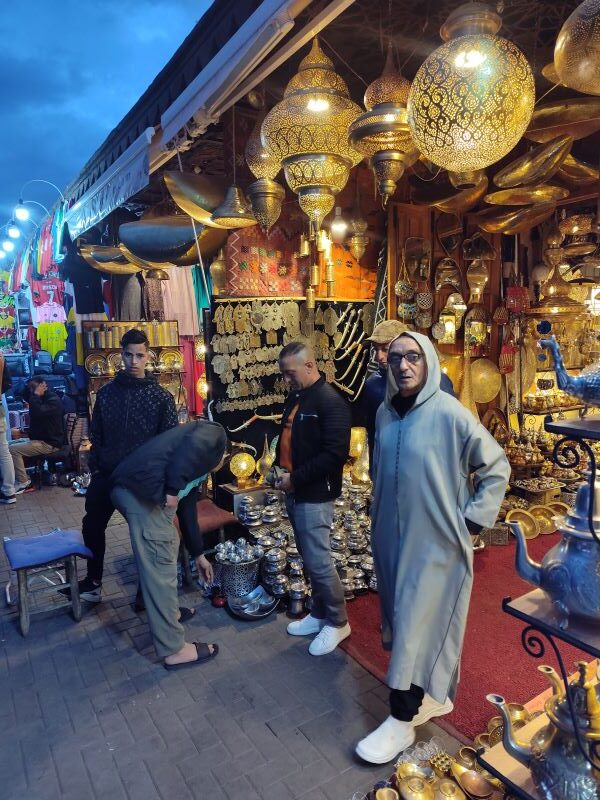
- Souk Semmarine: Main artery of the market with leather goods, slippers, and textiles.
Souk Semmarine is the main artery of Marrakesh’s Medina and often the first stop for visitors exploring the city’s markets. It stretches out from the lively Jemaa el-Fnaa square and serves as the entryway into the maze of smaller souks that branch off from it. This wide, covered passage is packed with shops selling leather bags, colorful slippers, woven textiles, brass lamps, and traditional Moroccan clothing. The energy is constant — merchants call out, tourists browse, and locals move swiftly through the crowd. To find Souk Semmarine, head north from Jemaa el-Fnaa toward the large archway just off the square; it’s clearly marked and easy to spot as one of the main entrances to the souk district.
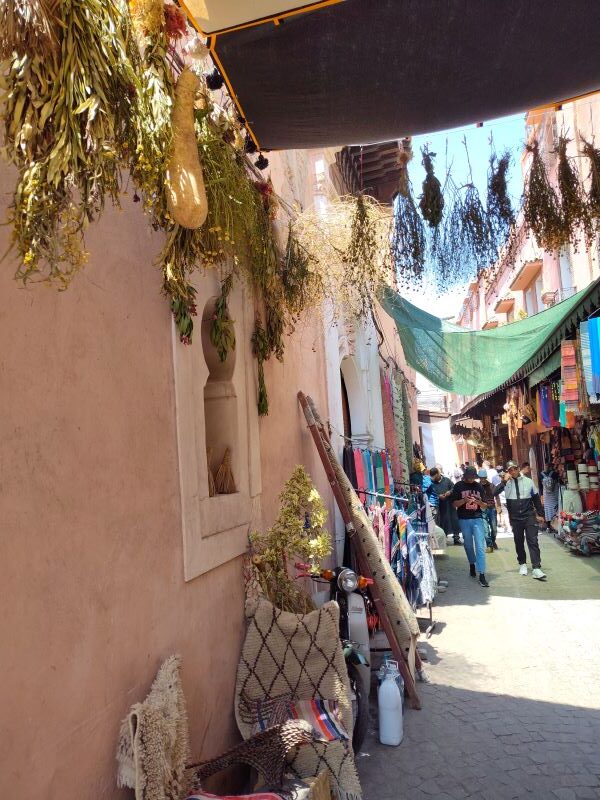
- Souk El Attarine: Known for perfumes, oils, and spices, filled with fragrant scents and colorful displays.
Souk El Attarine is one of the most aromatic and colorful corners of Marrakesh’s Medina, famous for its perfumes, spices, and essential oils. The narrow lanes here are lined with jars of saffron, cumin, and dried rose petals, alongside stalls selling ornate metal lamps and decorative goods. The scent of cedarwood, amber, and musk fills the air, giving the souk a distinct sensory charm. Many of the merchants here are long-time traders, offering quality spices and traditional Moroccan perfumes made with natural ingredients. To reach Souk El Attarine, start from Jemaa el-Fnaa and walk north through Souk Semmarine; follow the signs or continue straight until the scent of spices leads you to this lively section just a few minutes deeper into the market.
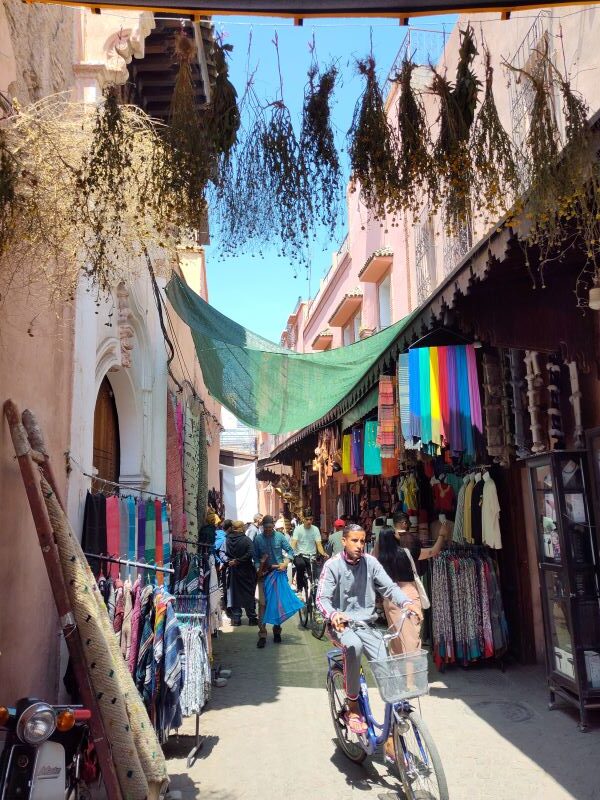
- Souk des Teinturiers (Dyers’ Souk): Features vibrant yarns hung to dry; visitors can watch the dyeing process.
Souk des Teinturiers, or the Dyers’ Souk, is one of the most colorful and photogenic parts of Marrakesh’s Medina. Here, bundles of vividly dyed wool and silk hang from wooden beams, drying in the open air, creating a rainbow of colors above the narrow alleys. Visitors can watch artisans at work using traditional dyeing methods passed down through generations, mixing natural pigments in steaming vats. The area offers a glimpse into the age-old textile trade that still thrives in Marrakesh today. To get there, start from Jemaa el-Fnaa and walk north through Souk Semmarine and Souk El Attarine, then follow the signs toward Rue Bab Debbagh or ask locals for “Souk des Teinturiers.” It’s located in the eastern part of the souk area, about a 10–15 minute walk from the main square.
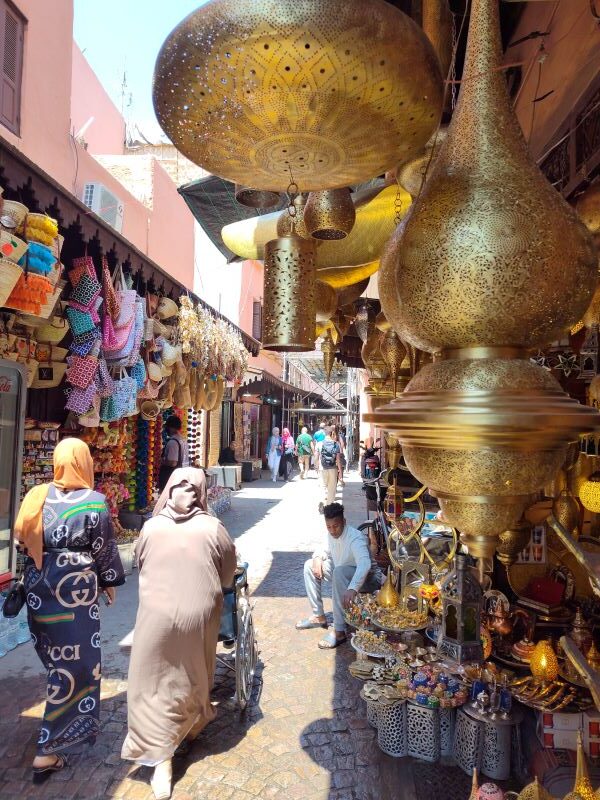
- Souk Haddadine: Dedicated to blacksmiths and metalworkers; the clanging of hammers fills the air.
Souk Haddadine, known as the Blacksmiths’ Souk, is where the rhythmic clanging of metal echoes through the Medina. This section of the Marrakesh souks is dedicated to ironwork and metal crafting, where artisans skillfully forge lanterns, locks, hinges, and decorative iron pieces using age-old techniques. The air is filled with sparks and the scent of hot metal as craftsmen hammer and shape their creations by hand. It’s an authentic corner of the market where visitors can witness the raw, hardworking side of traditional Moroccan artistry. To reach Souk Haddadine, start from Jemaa el-Fnaa and walk through Souk Semmarine toward the northern edge of the Medina, then follow signs or ask locals for “Souk Haddadine” near Place Rahba Kedima. It’s about a 10–15 minute walk from the main square, tucked away in the artisans’ quarter.
- Souk Cherratine: Specializes in leather goods, including belts, bags, and saddles.
Souk Cherratine is the leatherworkers’ market of Marrakesh, where the scent of tanned hides fills the air and rows of shops display finely crafted belts, bags, wallets, and traditional saddlery. This area has long been home to artisans specializing in leather goods, many of whom still use traditional hand-stitching and dyeing techniques. The atmosphere is a little quieter and more focused on craftsmanship than the busier central souks, making it a good place to browse quality handmade items at fair prices. To reach Souk Cherratine, start from Jemaa el-Fnaa and head north through Souk Semmarine and Souk El Attarine, then continue toward the Ben Youssef Madrasa. The souk is located just a few minutes from there, along Rue Cherratine, in the northern part of the Medina.
- Souk des Babouches: Focused on traditional Moroccan slippers (babouches) in many styles and colors.
Souk des Babouches, or the Slipper Market, is where Marrakesh’s famous leather slippers — known as babouches — are displayed in every color and style imaginable. Rows of tiny stalls overflow with neatly stacked slippers made from soft leather or suede, some plain and others embroidered or embellished with sequins. The craftsmanship here is impressive, with many artisans producing footwear by hand using techniques passed down through families. It’s a great place to pick up an authentic and practical Moroccan souvenir. To get there, start from Jemaa el-Fnaa and walk north through Souk Semmarine and Souk El Attarine, following the signs or asking for “Souk des Babouches.” It’s located near the Rahba Kedima square, right in the heart of the Medina’s market area.
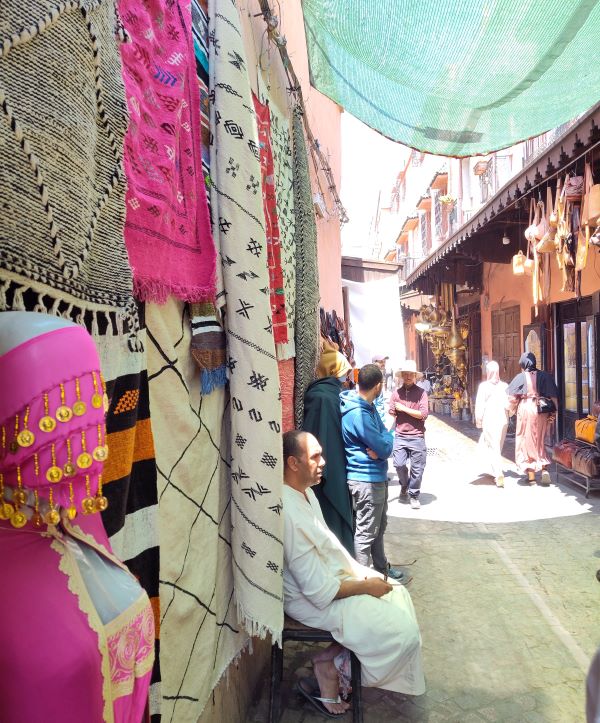
- Souk Zrabi: Carpet and rug market showcasing Berber and Moroccan weaving traditions.
Souk Zrabi, often called the Carpet Souk, is one of Marrakesh’s most visually rich and traditional markets. Here, vibrant Moroccan and Berber rugs are stacked high or draped across shop walls, creating a patchwork of color and texture. Traders showcase handwoven pieces from the Atlas Mountains and surrounding regions, each with distinct patterns and stories behind their designs. Bargaining is expected, but the experience is as much about appreciating the craftsmanship as it is about shopping. To reach Souk Zrabi, start at Jemaa el-Fnaa and walk north through Souk Semmarine toward Rahba Kedima square. From there, follow the small alleys leading northeast — the souk is located just beyond the spice market, about a 10-minute walk from the main square.
- Souk El-Kebir and Souk Chouari: Woodworkers’ area selling carved objects, furniture, and homeware.
Souk El-Kebir and Souk Chouari are neighboring markets known for their skilled woodworkers and craftsmen who produce everything from carved furniture and decorative boxes to kitchen utensils and intricate latticework. The sound of sawing and chiseling fills the air as artisans shape cedar and other local woods into both practical and artistic pieces. These souks have a more authentic, workshop-like feel compared to the more touristic areas, giving visitors a glimpse of Marrakesh’s traditional craftsmanship in action. To get there, start from Jemaa el-Fnaa and make your way north through Souk Semmarine, continuing past Souk El Attarine. Follow the path toward the northern end of the Medina near the Ben Youssef Madrasa — Souk El-Kebir and Souk Chouari sit side by side in this artisans’ district, about a 15-minute walk from the main square.
3. Products and Craftsmanship
- Common goods: spices, lamps, ceramics, jewelry, leather, textiles, and metalware.
- Many stalls feature artisans at work, giving insight into traditional Moroccan craftsmanship.
4. Layout and Navigation
- The souks are clustered north of Jemaa el-Fnaa square.
- Alleys are often unmarked, so wandering and exploring is part of the experience.
- Haggling is expected; it’s part of the shopping culture.
5. Tips for Visiting
- Visit in the morning for fewer crowds and cooler temperatures.
- Carry small cash; cards are rarely accepted.
- Be polite but firm when bargaining.
- Hire a local guide if you want to learn about specific crafts or avoid getting lost.
6. Overall Experience
- Visiting the souks offers a look into Marrakesh’s living traditions — a place where history, trade, and culture merge in everyday life. I love to explore and seeing all the amazing hand made crafts, textile and other specialty products made in the area.
Here’s a video tour experience and bargaining in the souks of Marrakesh below
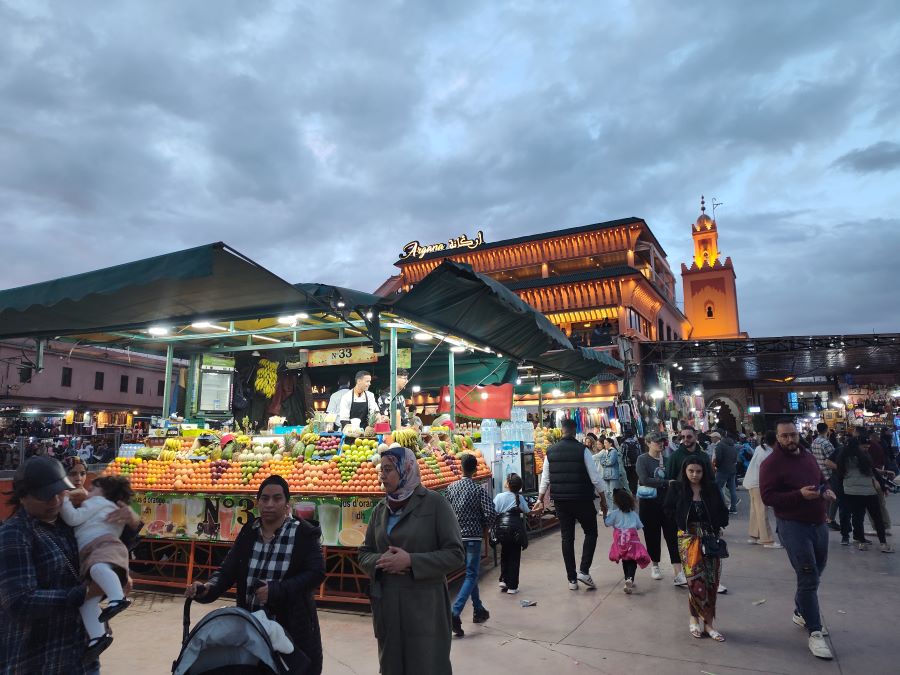
Further reading on Visiting Morocco
Check out these other topics to visiting Marrakesh and the surrounding areas
Explore the Medinas of Morocco
A visit to Tangier Kasbah Museum
A visit to Rabat, things to do
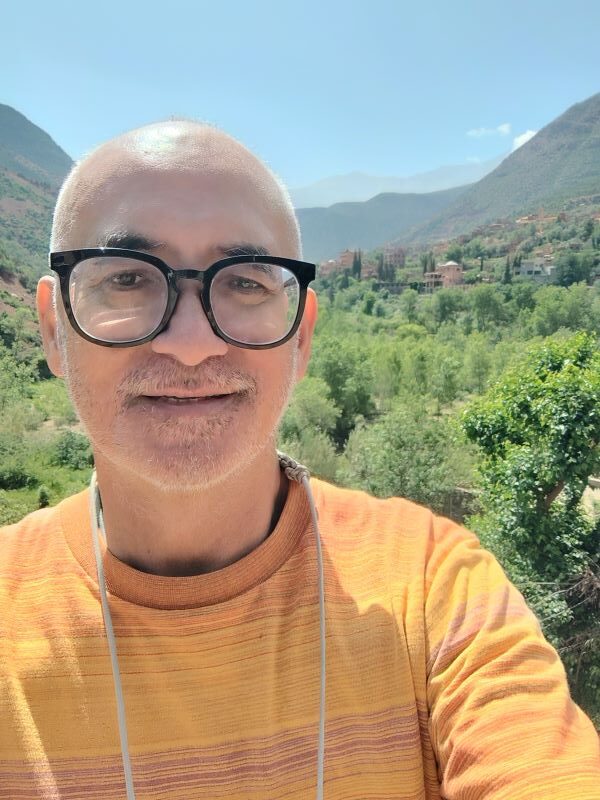
About author – Noel Morata
After relocating from the United States to Andalusia in 2024, I’ve made it my mission to discover every corner of Spain along with many Mediterranean locations, cities and attractions. Based just east of Granada, I’ve spent a lot of time visiting Morocco including multiple extended visits to Marrakesh, Tangier, Chefchaoen and different parts of the country throughout different seasons. My background in history cultural studies and years of residence and exploring all of the Mediterranean countries have given me unique insight into the region’s historical significance, local customs, and culinary traditions.
I regularly update my guides with the latest information gathered through personal visits and relationships with local tourism officials, always seeking what’s new and exciting in each destination. As a self-proclaimed foodie, I’m passionate about discovering authentic local markets and regional specialties.
If you love antiquities, art, design and craftsmanship, you must visit all the souks around Marrakesh – it is historic, filled with colorful markets and displays with surprises around every corner. I hope this post on visiting the souks of Marrakesh gives you an idea about the many different souks to explore in the area.
Disclosure – some of the links above to various tours, transportation and hotels are affiliate links that benefits our site if you book here and we appreciate your support. The links are competitive, and you are not paying above what other affiliates provide.

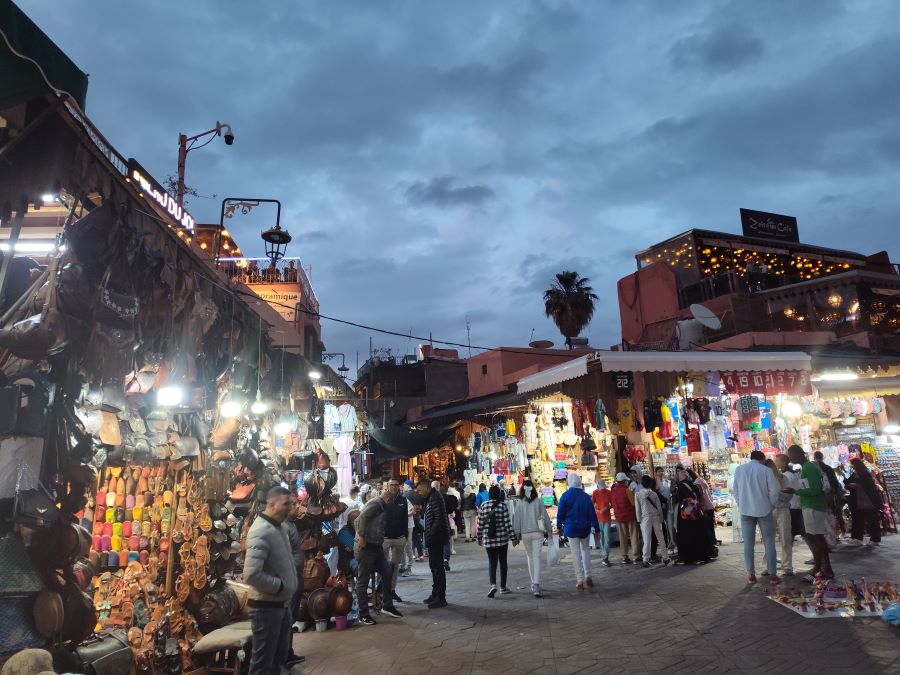
2 thoughts on “Souks of Marrakesh”